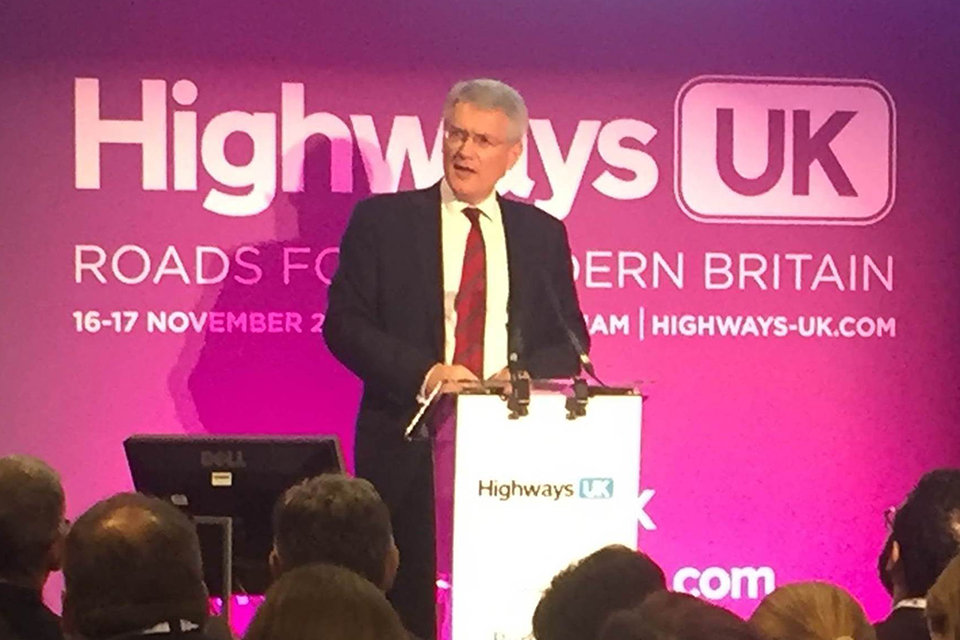Plans for an effective and reliable road network in the decades ahead
Transport Minister Andrew Jones' speech at Highways UK 2016.

Introduction
Thank you for inviting me to speak at this year’s Highways UK 2016 event.
It’s a pleasure to join you this morning.
I am pleased to see that the programme over the next 2 days covers a variety of themes.
Investment.
Skills and capacity.
Innovation and technology.
To name a few.
All key priorities for the government.
We all know the importance of having well maintained reliable highway infrastructure.
Our road network is the backbone of Britain.
95% of people use our road network every day.
Roads are vital lifelines for our economy.
Vital to our lives.
But if we want an effective, reliable road network in the decades ahead, we must work together to ensure that we are meeting the challenges.
Ask any road user what is one of their top priorities.
In the main the response will be the same, they want well maintained and modern infrastructure.
That is what we all want.
A safe, reliable, efficient and dare I say a pothole free journey.
A well maintained highway is good for competition, economic growth and our environment.
That is why the government has and continues to take action.

Transport Minister speech to Highways UK 2016.
Highways England
You will soon hear from Jim O’Sullivan who will no doubt highlight the largest investment programme for England’s strategic roads for a generation.
The Road investment strategy will see over £15 billion capital investment between 2015 and 2021 in our motorways and major ‘A’ roads.
It provides secure long term funding.
Investment that is helping people and goods travel efficiently around the country.
Investment that is key to continued economic growth.
April 2015 saw Highways England set up as a government-owned company to deliver the Road Investment Strategy.
In July this year, the department reported to Parliament on Highways England’s performance in its first year.
As you would expect, the first year was a settling in period for Highways England.
Adjusting to the new status and governance regime.
Building new relationships and strengthening established ones.
But at the same time, it added much-needed new capacity to the strategic road network.
Opening new stretches of smart motorway, and starting work on 8 major improvement schemes, one more than planned.
Highways England also rose to the challenges presented by the floods in Cumbria last winter - working with Cumbria County Council and other key local partners to re-build the A591 at Dunmail Raise.
Ensuring that its response will provide lasting benefit for road users and local residents.
In addition, whilst England’s strategic road network continues to be one of the safest road networks in the world, we are not complacent and safety has continued to be a key focus.
Highways England has set out a vision for reducing risks to the work force and road users alike in its ‘approach to health and safety’. I know this is a key issue for the Highways Term Maintenance Association.
This has been supported with more detailed plans and I hope that local highway authorities and their contractors will also participate to help embed an improved safety culture.
So, there has been good progress in delivering the ‘Road investment strategy’.
Local highways maintenance
We are also investing in maintaining local highways.
Between 2015 and 2021 we are providing over £6 billion for local highways maintenance.
That includes a £250 million fund specifically for repairing potholes; enough to repair over 4 million of them by 2021.
We have also tied an element of our funding to best practice and ensuring that authorities have an up to date asset management plan in place.
However, we cannot deliver this record level of investment without people and having a first class supply chain also in place.
Supply chain
We need more people with the right skills employed in the long term.
That means more skilled workers, attracting more graduates, and providing even more apprenticeships.
I am encouraged by the way the sector has over the last few years been stepping up to deliver and meet these challenges.
I know you will be hearing shortly from Sir Terry Morgan on the excellent work he has championed in respect to the Transport infrastructure skills strategy.
The strategy published earlier this year highlights key recommendations including:
- working to deliver our ambition for 30,000 new apprenticeships over the next 5 years
- ensuring the right mix of apprenticeships are on offer for the transport sector, including many at higher levels
- meet the challenge of new technologies by upskilling the existing workforce
- encouraging greater diversity in the workforce
- promoting transport and engineering as a career of choice for the brightest and best
But we need to look to technology and new innovative approaches also.
Technology
The highways sector needs to seize the opportunity to embrace technology to help deliver improved highways now and in the future.
Technology is transforming our society.
Our lives are becoming increasingly digital, and increasingly connected.
Transport is no different, and we are in the foothills of seismic changes in transport, driven by emerging technologies and markets.
Digital transformation is enabling enhanced public service delivery and integration, making our cities smarter, and giving our citizens better access to information and choice of services.
OS MasterMap
I am pleased today to see that Ordnance Survey will be launching the OS MasterMap Highways Network.
This is a new road network dataset that brings together the best available information on our roads to create a single authoritative view of the network.
The Department for Transport (DfT) invested £3 million in the project and I am really pleased that the dataset will be the most comprehensive digital record of the road network to date.
It has a wide range of applications and benefits.
By creating one authoritative source, all of government, including local government, will have a definitive point of reference for all current and future policies, reducing the burden of data exchange and maintenance of multiple sources. Other benefits include:
- improved journey planning
- greater transparency
- enabling emerging technologies
- a common base for road statistics
Like the OS MasterMap, Big Data and the ‘Internet of Things’ are making our infrastructure smarter, allowing us to assess the condition and manage highways and other critical infrastructure more intelligently and efficiently – reducing costs and disruption to the public, and improving resilience.
I know there are a number of companies already using video and other camera technology to help authorities understand more about the assets they are responsible for.
This will help better decision making.
Improve efficiency and leading to more planned and cost effective works to be undertaken as part of good asset management.
Vehicle technologies are already changing the way we drive, and eventually are set to change the very nature of our relationship with the car.
These technologies, as well as new advanced materials, energy technologies and nanotechnology, herald rapid and dramatic changes for our highways.
There are enormous benefits on offer here, both for individual users, and for our economy and society.
You – the supply chain, technology companies and the people that manage and operate our networks – are a vital part of nurturing highways innovation.
By working collaboratively to develop and apply new ideas, technologies and ways of working that can deliver better outcomes for lower cost.
We need everybody to embrace this way forward.
It is about having an open-minded approach.
One where both standards and procurement approaches do not stifle new ideas – but are flexible and intelligent enough to encourage and incentivise innovation, whilst not compromising safety, and where successes can be promulgated.
As government, we are here to enable this to happen.
Innovation and technology are a crucial part of delivering our ambition to revolutionise our roads and create a modern road network that supports a modern Britain.
And we are taking an ambitious approach.
Our world-class innovation infrastructure and ambitious funding programmes are putting Britain at the forefront of innovation in road transport, and making Britain the best place in the world to do transport digitally.
We are establishing Britain as a global leader in the development and introduction of new vehicle technologies.
Investing over £100 million in research and demonstration projects for connected and automated vehicles.
And over £900 million to position the UK at the global forefront of the development, manufacture and use of ultra-low emission vehicles.
The first Road investment strategy is incentivising highways innovation through strong efficiency targets, and providing Highways England with £150 million of funding for innovation.
Through Innovate UK, we have established the network of Catapult Centres to identify innovations and help bring them to market quickly.
We are funding major Smart City demonstrators across the country, and have backed the Cambridge Centre for Smart Infrastructure and Construction to promote smart infrastructure technologies across sectors.
Conclusion
Having a highway that is fit for purpose will help our industries thrive and ensure businesses can deliver but also allowing all users to benefit from excellent infrastructure.
That is why events such as Highways UK 2016 are important forums to bring together the sector.
Collaborating together will ensure that we all deliver a well maintained highway network that keeps businesses in touch with their customers, unites families and friends, and gives people access to employments, education and training.
Thank You.